Quantitative Analysis and Human Health Risk Assessment of Heavy Metals in Paddy Plants Collected from Perak, Malaysia
Abstract
:1. Introduction
2. Materials and Methods
2.1. Study Areas and Sampling
2.2. Sample Preparation and Heavy Metals Extraction from Soil
2.3. Sample Preparation and Heavy Metals Extraction from Paddy Plants
2.4. Inductively Coupled Plasma-Mass Spectrometry (ICP-MS)
Instrumentation
2.5. Heavy Metal Absorption and Transferability
2.5.1. Enrichment Factor (EF)
2.5.2. Translocation Factor (TF)
2.6. Human Health Risk Assessment
2.6.1. Average Daily Dose (ADD)
2.6.2. Noncarcinogenic Risk
2.6.3. Carcinogenic Risk
2.7. Statistical Analysis
3. Results and Discussion
3.1. Quantification of Heavy Metals in Different Parts of Paddy Plants
3.2. Quantification of Heavy Metals in Paddy Soils
3.3. Heavy Metal Absorption and Transferability
3.3.1. Enrichment Factor (EF)
3.3.2. Translocation Factor (TF)
3.4. Pattern Recognition of Heavy Metal Contamination in Different Sampling by PCA
3.5. Health Risk Assessment
3.5.1. Average Daily Dose (ADD)
3.5.2. Noncarcinogenic Risk Assessment
3.5.3. Carcinogenic Risk Assessment
4. Conclusions
Supplementary Materials
Author Contributions
Funding
Institutional Review Board Statement
Informed Consent Statement
Data Availability Statement
Acknowledgments
Conflicts of Interest
References
- Fan, Y.; Zhu, T.; Li, M.; He, J.; Huang, R. Heavy metal contamination in soil and brown rice and human health risk assessment near three mining areas in Central China. J. Healthc. Eng. 2017, 2017, 4124302. [Google Scholar] [CrossRef] [PubMed]
- Guo, B.; Hong, C.; Tong, W.; Xu, M.; Huang, C.; Yin, H.; Lin, Y.; Fu, Q. Health risk assessment of heavy metal pollution in a soil-rice system: A case study in the Jin-Qu Basin of China. Sci. Rep. 2020, 10, 1–11. [Google Scholar] [CrossRef]
- Wuana, R.A.; Okieimen, F.E. Heavy metals in contaminated soils: A review of sources, chemistry, risks and best available strategies for remediation. ISRN Ecol. 2011, 2011, 402647. [Google Scholar] [CrossRef] [Green Version]
- Rahimi, G.; Kolahchi, Z.; Charkhabi, A. Uptake and translocation of some heavy metals by rice crop (Oryza sativa) in paddy soils. Agriculture 2017, 63, 163–175. [Google Scholar] [CrossRef] [Green Version]
- Bandumula, N. Rice production in Asia: Key to global food security. Proc. Natl. Acad. Sci. India Sect. B-Biol. Sci. 2018, 88, 1323–1328. [Google Scholar] [CrossRef]
- Abubakar, B.; Yakasai, H.M.; Zawawi, N.; Ismail, M. Compositional analyses of white, brown and germinated forms of popular Malaysian rice to offer insight into the growing diet-related diseases. J. Food Drug Anal. 2018, 26, 706–715. [Google Scholar] [CrossRef] [PubMed] [Green Version]
- Satpathy, D.; Reddy, M.V.; Dhal, S.P. Risk assessment of heavy metals contamination in paddy soil, plants, and grains (Oryza sativa L.) at the east coast of India. Biomed Res. Int. 2014, 2014, 545473. [Google Scholar] [CrossRef] [Green Version]
- Kasim, N.B.M.; Ahmad, M.H.B.; Shaharudin, A.B.B.; Naidu, B.M.; Ying, C.Y.; Aris, T.B. Food choices among Malaysian adults: Finding from Malaysian Adults Nutrition Survey (MANS) 2003–2014. Malays. J. Nutr. 2018, 24, 63–75. [Google Scholar]
- Rahim, F.H.A.; Hawari, N.N.; Abidin, N.Z. Supply and demand of rice in Malaysia: A system dynamics approach. Int. J. Sup. Chain. Mgt. 2017, 6, 1–7. [Google Scholar]
- Zulkafflee, N.S.; Redzuan, N.A.M.; Selamat, J.; Ismail, M.R.; Praveena, S.M.; Razis, A.F.A. Evaluation of heavy metal contamination in paddy plants at the northern region of Malaysia using ICPMS and its risk assessment. Plants 2020, 10, 3. [Google Scholar] [CrossRef]
- Khairiah, J.; Ramlee, A.R.; Jamil, H.; Ismail, Z.; Ismail, B.S. Heavy metal content of paddy plants in Langkawi, Kedah, Malaysia. Aust. J. Basic Appl. Sci. 2013, 7, 123–127. [Google Scholar]
- Khairiah, J.; Habibah, H.J.; Anizan, I.; Maimon, A.; Aminah, A.; Ismail, B.S. Content of heavy metals in soil collected from selected paddy cultivation areas in Kedah and Perlis, Malaysia. J. Appl. Sci. Res. 2009, 5, 2179–2188. [Google Scholar]
- Juen, L.L.; Aris, A.Z.; Ying, L.W.; Haris, H.A. Bioconcentration and translocation efficiency of metals in paddy (Oryza sativa): A case study from Alor Setar, Kedah, Malaysia. Sains Malays. 2014, 43, 521–528. [Google Scholar]
- Alrawiq, N.; Khairiah, J.; Talib, M.L.; Ismail, B.S.; Anizan, I. Accumulation and translocation of heavy metals in paddy plant selected from recycled and non-recycle water area of MADA Kedah, Malaysia. Int. J. ChemTech Res. 2014, 6, 2347–2356. [Google Scholar]
- Zulkafflee, N.S.; Mohd Redzuan, N.A.; Hanafi, Z.; Selamat, J.; Ismail, M.R.; Praveena, S.M.; Abdull Razis, A.F. Heavy metal in paddy soil and its bioavailability in rice using in vitro digestion model for health risk assessment. Int. J. Environ. Res. Public Health 2019, 16, 4769. [Google Scholar] [CrossRef] [PubMed] [Green Version]
- Payus, C.; Talip, A.F.A. Assessment of heavy metals accumulation in paddy rice (Oryza sativa). African J. Agric. Res. 2014, 9, 3082–3090. [Google Scholar]
- Yap, D.W.; Adezrian, J.; Khairiah, J.; Ismail, B.S.; Ahmad-Mahir, R. The uptake of heavy metals by paddy plants (Oryza sativa) in Kota Marudu, Sabah, Malaysia. Am. Eurasian J. Agric. Env. Sci. 2009, 6, 16–19. [Google Scholar]
- Adlane, B.; Xu, Z.; Xu, X.; Liang, L.; Han, J.; Qiu, G. Evaluation of the potential risks of heavy metal contamination in rice paddy soils around an abandoned Hg mine area in Southwest China. Acta Geochim. 2020, 39, 85–95. [Google Scholar] [CrossRef]
- Lorestani, B.; Cheraghi, M.; Yousefi, N. Accumulation of Zb, Fe, Mn, Cu and Zn in plants and choice of hyperaccumulator plant in the industrial town of Vian, Iran. Arch. Biol. Sci. 2011, 63, 739–745. [Google Scholar] [CrossRef]
- Praveena, S.M.; Omar, N.A. Heavy metal exposure from cooked rice grain ingestion and its potential health risks to humans from total and bioavailable forms analysis. Food Chem. 2017, 235, 203–211. [Google Scholar] [CrossRef] [PubMed]
- United States Environmental Protection Agency (USEPA). Integrated Risk Information System (IRIS). 2014. Available online: www.epa.gov/IRIS (accessed on 28 November 2018).
- Hadif, W.M.; Rahim, S.A.; Sahid, I.; Bhuiyan, A.R.; Ibrahim, I. Heavy metals accumulation in parts of paddy Oryza sativa L. grown in paddy field adjacent to ultrabasic soil. In AIP Conference Proceedings; AIP Publishing LLC: Melville, NY, USA, 2015; Volume 1678. [Google Scholar]
- Malaysian Food Regulations. Food Act 1983 (Act 281) & Regulations; International Law Book Services: Kuala Lumpur, Malaysia, 1985. [Google Scholar]
- Joint FAO; World Health Organization; WHO Expert Committee on Food Additives. Evaluation of Certain Food Additives: Eighty-Second Report of the Joint FAO; WHO Technical Report Series; WHO: Geneva, Switzerland, 2016.
- Tariq, S.R.; Rashid, N. Multivariate analysis of metal levels in paddy soil, rice plants, and rice grains: A case study from Shakargarh, Pakistan. J. Chem. 2013, 2013, 539251. [Google Scholar] [CrossRef]
- Nanjing Institute of Environmental Sciences; Ministry of Ecology and Environment of China. Soil Environmental Quality Risk Control Standard for Soil Contamination of Agricultural Land; GB15618-2018; Ministry of Ecology and Environment of China: Beijing, China, 2018.
- European Union. Heavy Metals in Wastes. European Commission on Environment. Available online: http://ec.europa.eu/environment/waste/studies/pdf/heavymetalsreport.pdf (accessed on 24 October 2018).
- Gupta, S.; Nayek, S.; Saha, R.N.; Satpati, S. Assessment of heavy metal accumulation in macrophyte, agricultural soil, and crop plants adjacent to discharge zone of sponge iron factory. Environ. Geol. 2008, 55, 731–739. [Google Scholar] [CrossRef]
- Khan, S.; Cao, Q.; Zheng, Y.M.; Huang, Y.Z.; Zhu, Y.G. Health risks of heavy metals in contaminated soils and food crops irrigated with wastewater in Beijing, China. Environ. Pollut. 2008, 152, 686–692. [Google Scholar] [CrossRef]
- Neeratanaphan, L.; Khamma, S.; Benchawattananon, R.; Ruchuwararak, P.; Appamaraka, S.; Intamat, S. Heavy metal accumulation in rice (Oryza sativa) near electronic waste dumps and related human health risk assessment. Hum. Ecol. Risk Assess. An Int. J. 2017, 23, 1086–1098. [Google Scholar] [CrossRef]
- Singh, J.; Upadhyay, S.K.; Pathak, R.K.; Gupta, V. Accumulation of heavy metals in soil and paddy crop (Oryza sativa), irrigated with water of Ramgarh Lake, Gorakhpur, UP, India. Toxicol. Environ. Chem. 2011, 93, 462–473. [Google Scholar] [CrossRef]
- Granato, D.; Santos, J.S.; Escher, G.B.; Ferreira, B.L.; Maggio, R.M. Use of principal component analysis (PCA) and hierarchical cluster analysis (HCA) for multivariate association between bioactive compounds and functional properties in foods: A critical perspective. Trends Food Sci. Technol. 2018, 72, 83–90. [Google Scholar] [CrossRef]
- FAO/WHO. Evaluation of Certain Food Additives and Contaminants, Twenty-Six Report of the Joint FAO/WHO Expert Committee on Food Additives; World Health Organization: Geneva, Switzerland, 1982. [Google Scholar]
- FAO/WHO. Evaluation of Certain Food Additives and Contaminants, Thirty-Third Report of the Joint FAO/WHO Expert Committee on Food Additives; World Health Organization: Geneva, Switzerland, 1989. [Google Scholar]
- FAO/WHO. Evaluation of Certain Food Additives and Contaminants, Seventy-Third Report of the Joint FAO/WHO Expert Committee on Food Additives; World Health Organization: Geneva, Switzerland, 2011. [Google Scholar]
- Deng, Z.H.; Zhang, A.; Yang, Z.W.; Zhong, Y.L.; Mu, J.; Wang, F.; Liu, Y.X.; Zhang, J.J.; Fang, Y.L. A human health risk assessment of trace elements present in Chinese wine. Molecules 2019, 24, 248. [Google Scholar] [CrossRef] [Green Version]
- Qu, C.S.; Ma, Z.W.; Yang, J.; Liu, Y.; Bi, J.; Huang, L. Human exposure pathways of heavy metals in a lead-zinc mining area, Jiangsu Province, China. PLoS ONE 2012, 7, e46793. [Google Scholar] [CrossRef] [Green Version]

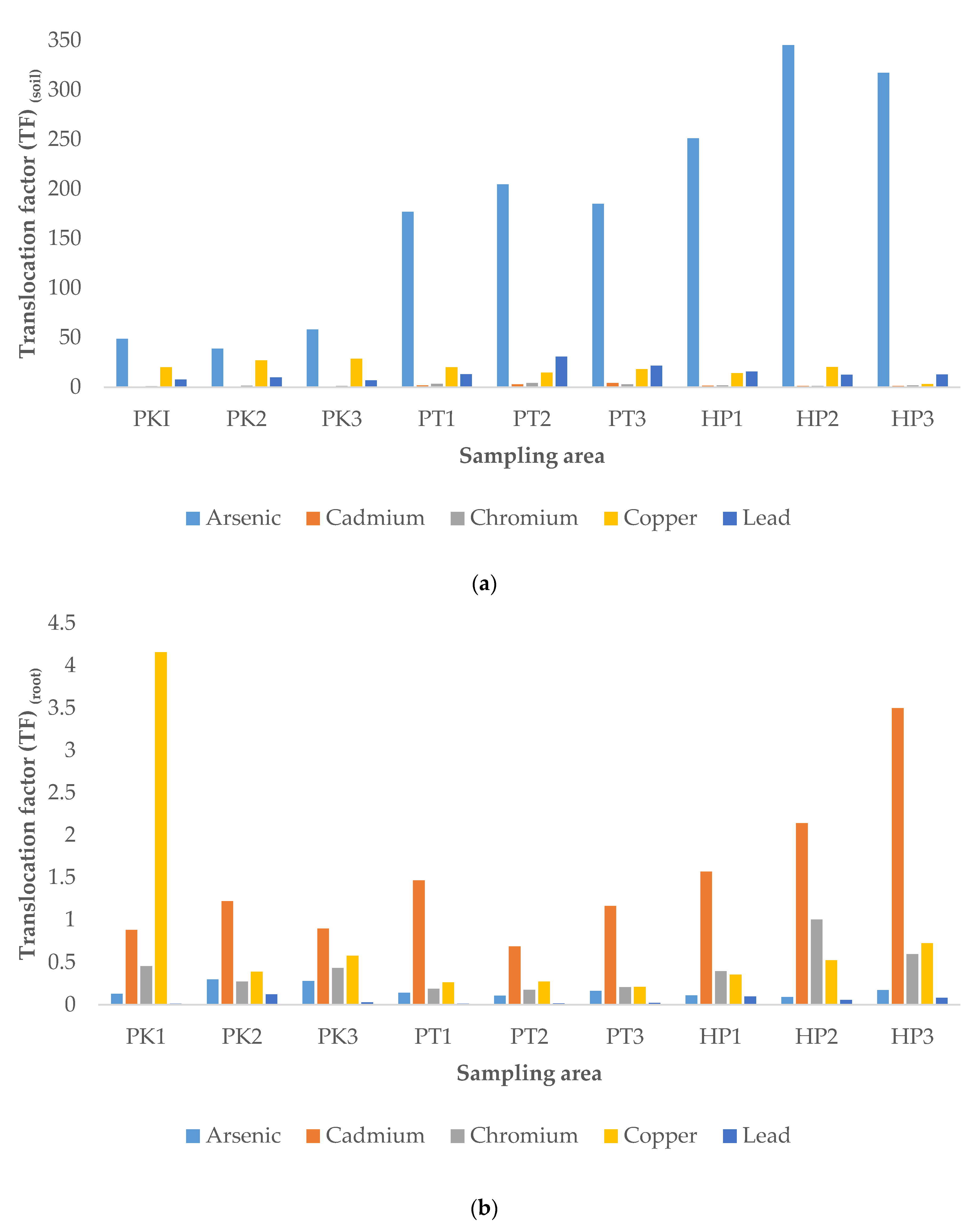
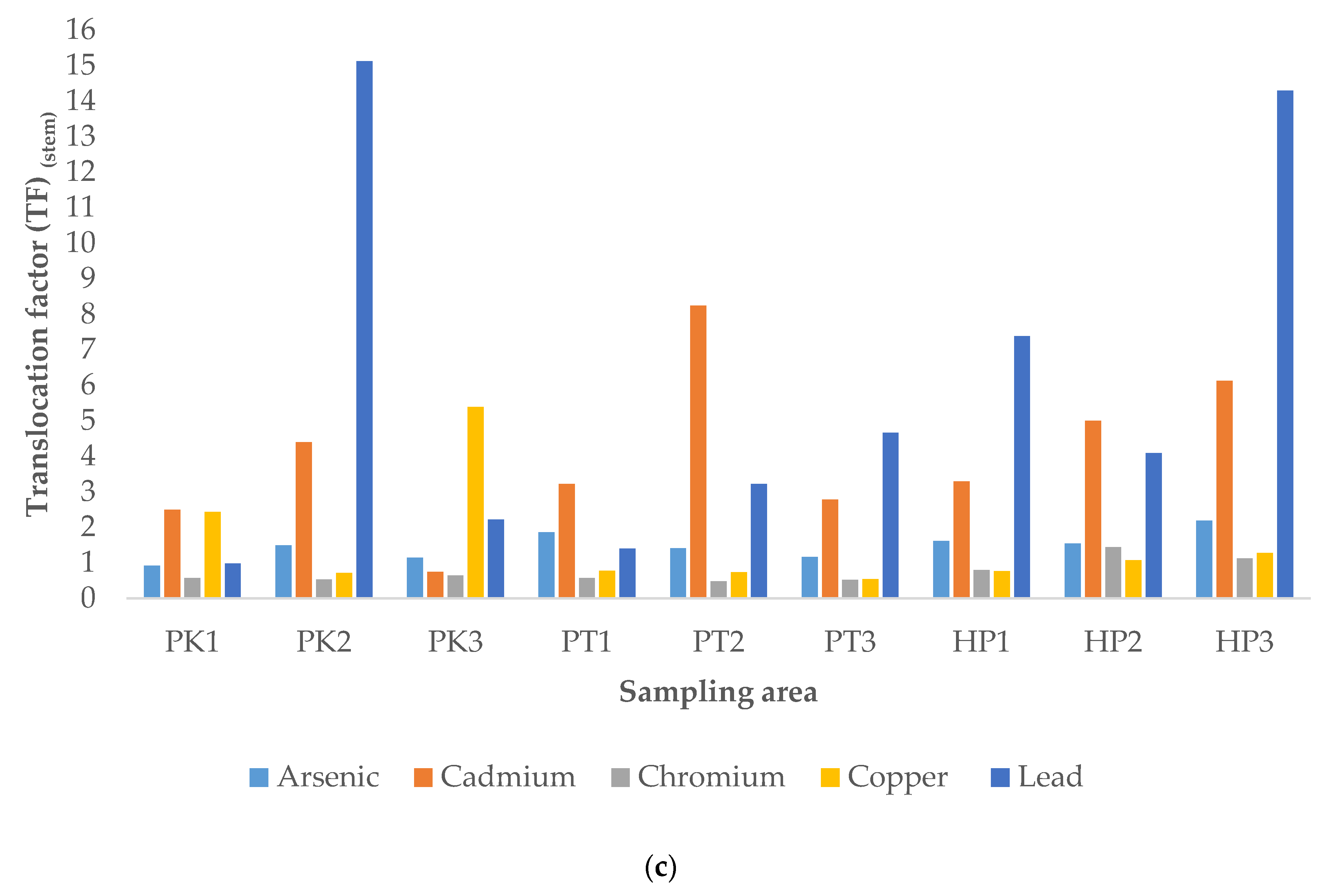
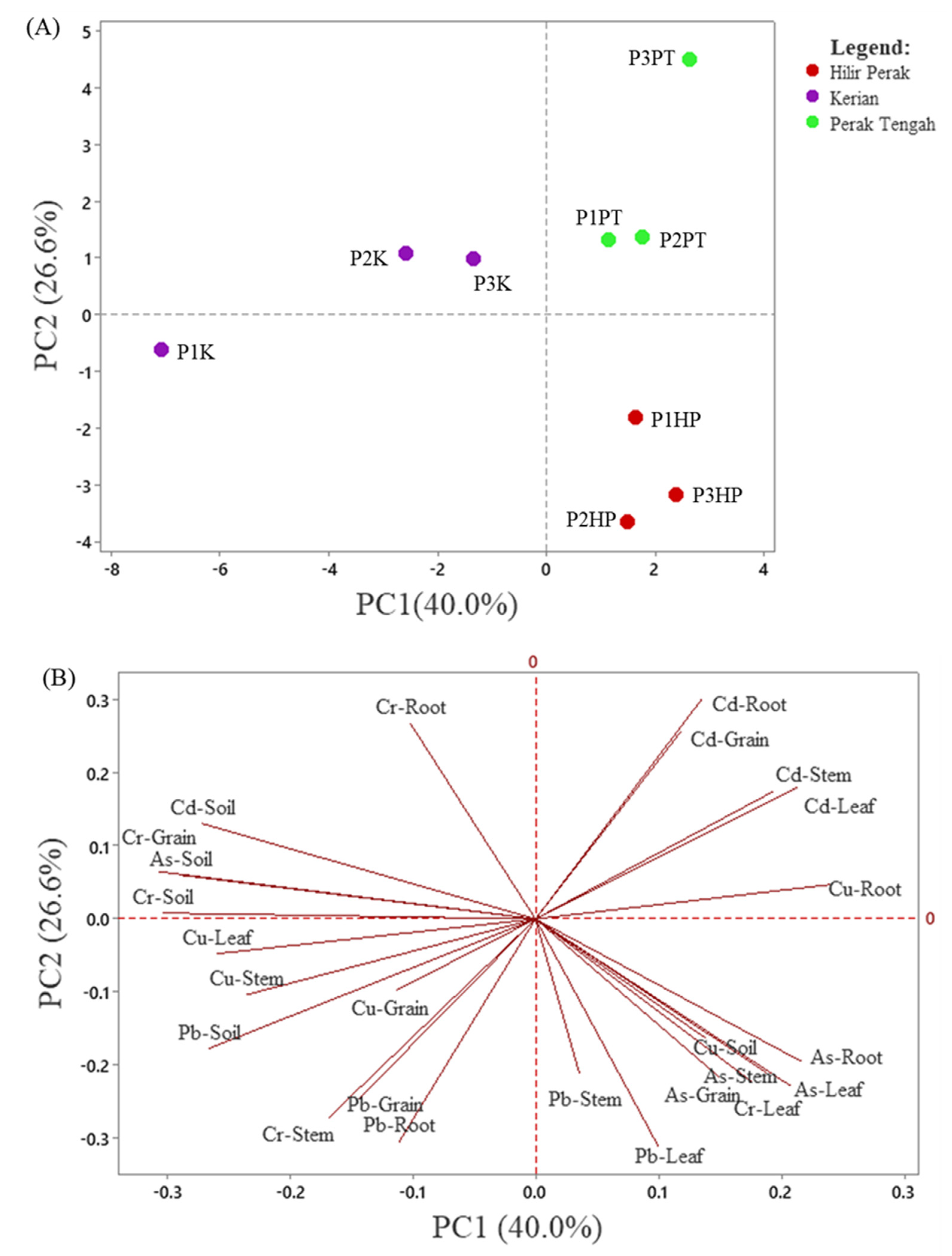
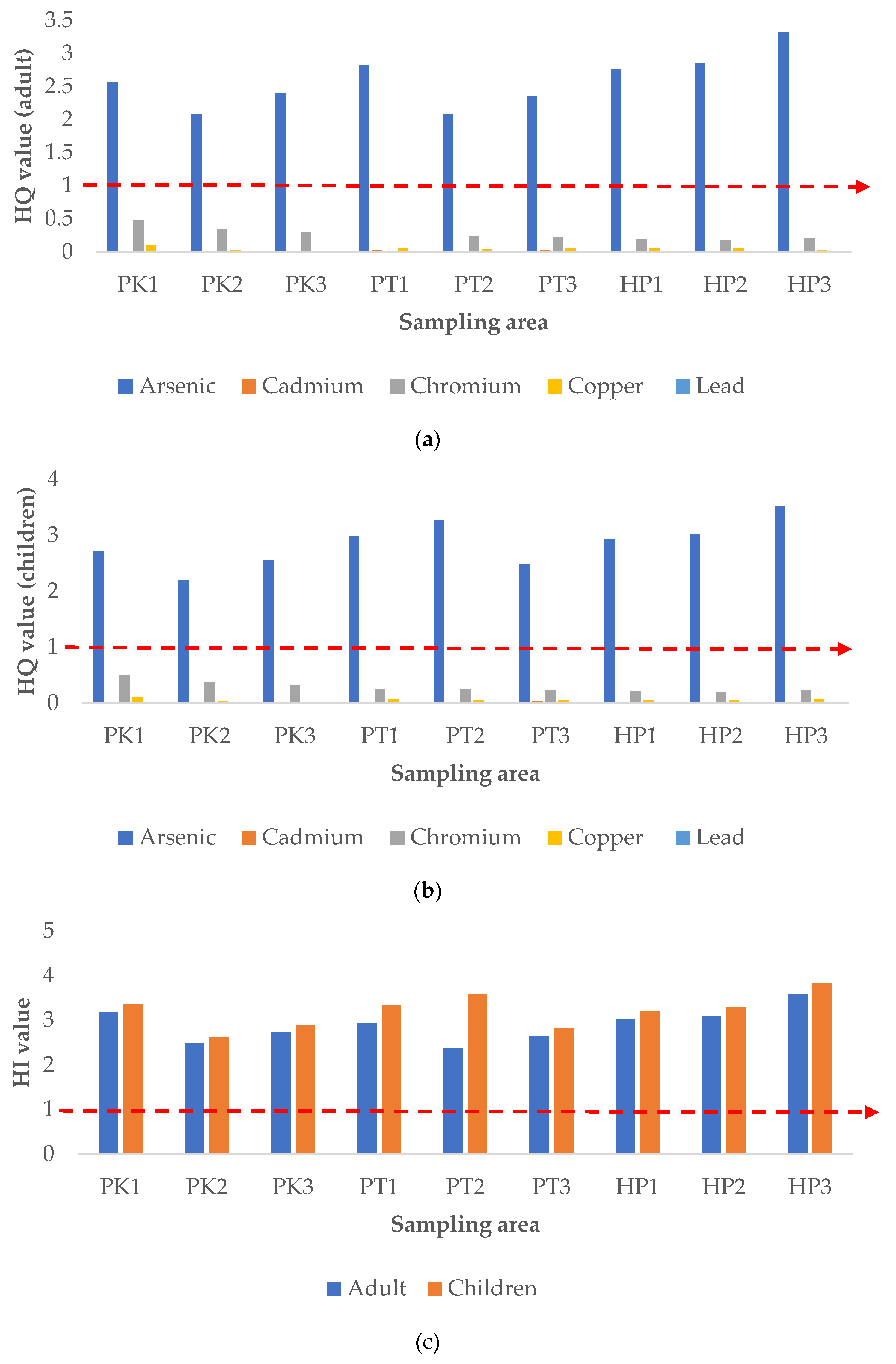

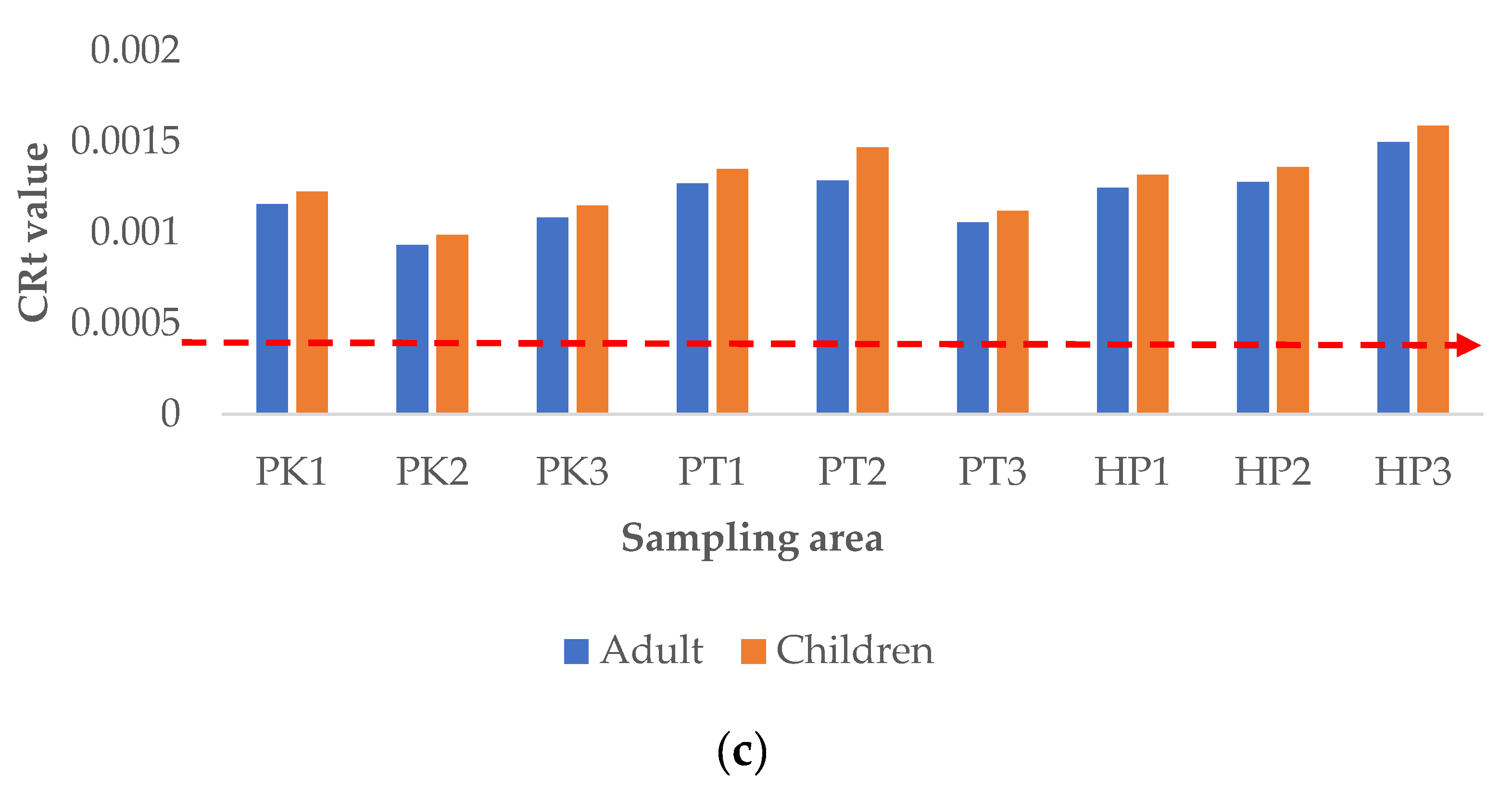
| Items | Set Values |
|---|---|
| RF power | 1200 W |
| Gas mode | He mode |
| Carrier gas | 0.6–0.8 L/min |
| Dilution gas | 0.40–0.60 L/min |
| Sampling depth | 10.0–11.0 mm |
| Nebuliser | Miramist |
| Nebuliser gas flow | 0.5 rps |
| Spray chamber | Quarts Scott style spray chamber (2 °C) |
| Interface cones | Platinum sampler and skimmer cones |
| Paddy Plant Parts | Plot | Concentration of Heavy Metals (mg/kg) | ||||
|---|---|---|---|---|---|---|
| Arsenic (As) | Cadmium (Cd) | Chromium (Cr) | Copper (Cu) | Lead (Pb) | ||
| Root As > Pb > Cr > Cu > Cd | P1K | 0.57 ± 0.0070 d | 0.0017 ± 0.000047 cd | 0.19 ± 0.013 ab | 0.064 ± 0.00078 ef | 0.40 ± 0.0046 a |
| P2K | 0.33 ± 0.017 e | 0.0018 ± 0.00018 cd | 0.22 ± 0.040 a | 0.068 ± 0.0059 e | 0.30 ± 0.044 cd | |
| P3K | 0.32 ± 0.060 e | 0.0010 ± 0.000074 e | 0.14 ± 0.0021 bc | 0.052 ± 0.0038 f | 0.21 ± 0.014 e | |
| Stem As > Cu > Pb > Cr > Cd | P1K | 0.075 ± 0.0012 c | 0.0015 ± 0.000094 ed | 0.086 ± 0.0040 a | 0.27 ± 0.023 a | 0.0051 ± 0.00045 cd |
| P2K | 0.097 ± 0.0023 c | 0.0022 ± 0.000048 de | 0.060 ± 0.0022 bc | 0.027 ± 0.0003 d | 0.036 ± 0.048 c | |
| P3K | 0.090 ± 0.0014 c | 0.00090 ± 0.000015 f | 0.061 ± 0.0043 bcd | 0.030 ± 0.0010 d | 0.0060 ± 0.00043 cd | |
| Leaf As > Cu > Cr > Pb > Cd | P1K | 0.13 ± 0.011 d | 0.00030 ± 0.000072 f | 0.015 ± 0.044 a | 1.6 ± 0.47 a | 0.011 ± 0.0011 ef |
| P2K | 0.12 ± 0.015 d | 0.00080 ± 0.00012 de | 0.058 ± 0.0031 c | 0.043 ± 0.0077 b | 0.017 ± 0.0021 de | |
| P3K | 0.12 ± 0.0045 d | 0.00060 ± 0.000011 ef | 0.078 ± 0.018 bc | 0.062 ± 0.0032 b | 0.019 ± 0.00077 d | |
| Grain As > Cr > Cu > Pb > Cd | P1K | 0.081 ± 0.0051 cde | 0.00060 ± 0.000050 bc | 0.15 ± 0.0036 a | 0.11 ± 0.0023 a | 0.0052 ± 0.0040 a |
| P2K | 0.065 ± 0.0057 e | 0.00050 ± 0.00008 c | 0.11 ± 0.0040 b | 0.037 ± 0.0060 d | 0.0024 ± 0.0004 a | |
| P3K | 0.076 ± 0.0050 cde | 0.0012 ± 0.0016 bc | 0.094 ± 0.011 c | 0.0056 ± 0.012 bc | 0.0027 ± 0.00060 a | |
| Food Regulation 1985 A | 1.0 | 1.0 | - | - | 2.0 | |
| CODEX Standard B | 1.4 | 0.4 | 1.0 | 30 | 0.20 | |
| Paddy Plant Parts | Plot | Concentration of Heavy Metals (mg/kg) | ||||
|---|---|---|---|---|---|---|
| Arsenic (As) | Cadmium (Cd) | Chromium (Cr) | Copper (Cu) | Lead (Pb) | ||
| Root As > Pb > Cr > Cu > Cd | P1PT | 1.2 ± 0.088 b | 0.0048 ± 0.00029 b | 0.22 ± 0.013 a | 0.16 ± 0.0082 a | 0.31 ± 0.019 bc |
| P2PT | 1.3 ± 0.12 b | 0.0048 ± 0.00027 b | 0.21 ± 0.027 a | 0.14 ± 0.0056 b | 0.26± 0.012 d | |
| P3PT | 0.83 ± 0.028 c | 0.0079 ± 0.00021 a | 0.17 ± 0.0047 abc | 0.13 ±0.0031 b | 0.18 ±0.0041 e | |
| Stem As > Cu > Cr > Cd > Pb | P1PT | 0.16 ± 0.013 b | 0.0071 ± 0.00069 b | 0.042 ± 0.0036 de | 0.051 ± 0.0043 cd | 0.0046 ± 0.00020 cd |
| P2PT | 0.14 ± 0.026 b | 0.0033 ± 0.00079 d | 0.036 ± 0.0051 e | 0.037 ± 0.0072 cd | 0.0039 ± 0.00097 d | |
| P3PT | 0.086 ± 0.0086 c | 0.0092 ± 0.00017 a | 0.039± 0.0027 e | 0.028 ± 0.00037 d | 0.0042 ± 0.0014 d | |
| Leaf As > Cu > Cr > Pb > Cd | P1PT | 0.27 ± 0.0023 bc | 0.0010 ± 0.000018 cd | 0.053 ± 0.0054 c | 0.060 ±0.0048 b | 0.0085 ± 0.00026 f |
| P2PT | 0.24 ± 0.016 c | 0.0015 ± 0.000083 b | 0.047 ± 0.0028 c | 0.082 ±0.0081 b | 0.011 ±0.00025 ef | |
| P3PT | 0.15 ± 0.0093 d | 0.0033 ± 0.0016 a | 0.052 ± 0.0022 c | 0.073 ± 0.013 b | 0.0084 ± 0.0012 f | |
| Grain As > Cr > Cu > Pb > Cd | P1PT | 0.089 ± 0.0038 bcd | 0.0022 ± 0.00014 ab | 0.073 ± 0.0053 d | 0.065 ± 0.0064 bc | 0.0033 ± 0.0014 a |
| P2PT | 0.097 ± 0.0014 ab | 0.00040 ± 0.000043 c | 0.075 ± 0.0020 d | 0.050 ± 0.0014 cd | 0.0012 ± 0.000034 a | |
| P3PT | 0.074 ± 0.0050 de | 0.0033 ± 0.00016 a | 0.069 ± 0.0044 d | 0.051 ± 0.0032 cd | 0.00090 ± 0.000036 a | |
| Food Regulation 1985 A | 1.0 | 1.0 | - | - | 2.0 | |
| CODEX standard B | 1.4 | 0.40 | 1.0 | 30 | 0.20 | |
| Paddy Plant Part | Plot | Concentration of Heavy Metals (mg/kg) | ||||
|---|---|---|---|---|---|---|
| Arsenic (As) | Cadmium (Cd) | Chromium (Cr) | Copper (Cu) | Lead (Pb) | ||
| Root As > Pb > Cu > Cr > Cd | P1HP | 1.3 ± 0.016 b | 0.0021 ± 0.000075 c | 0.12 ± 0.0040 cd | 0.12 ± 0.0029 cd | 0.34 ± 0.0021 abc |
| P2HP | 1.5 ± 0.12 a | 0.0014 ± 0.00016 de | 0.082 ± 0.0088 d | 0.11 ± 0.0036 d | 0.36 ± 0.011 ab | |
| P3HP | 1.3 ± 0.082 ab | 0.0014 ± 0.000097 de | 0.12 ± 0.0098 cd | 0.12 ± 0.0072 bc | 0.35 ± 0.021 ab | |
| Stem As > Cr > Cu > Pb > Cd | P1HP | 0.14 ± 0.0014 b | 0.0033 ± 0.00032 d | 0.049 ± 0.0032 cde | 0.041 ± 0.0044 cd | 0.034 ± 0.045 c |
| P2HP | 0.14 ± 0.012 b | 0.0030 ± 0.00034 d | 0.082 ± 0.013 a | 0.056 ± 0.0072 c | 0.021 ± 0.0033 b | |
| P3HP | 0.23 ± 0.021 a | 0.0049 ± 0.00041 c | 0.074 ± 0.0098 ab | 0.089 ± 0.0071 b | 0.029 ± 0.031 a | |
| Leaf As > Pb > Cu > Cr > Cd | P1HP | 0.30 ± 0.022 ab | 0.0015 ± 0.00012 b | 0.088 ± 0.0036 bc | 0.09 ± 0.068 b | 0.050 ± 0.045 b |
| P2HP | 0.27 ± 0.013 bc | 0.0013 ± 0.00011 bc | 0.12 ± 0.017 ab | 0.12± 0.0012 b | 0.087 ± 0.0046 a | |
| P3HP | 0.33 ± 0.035 a | 0.0012 ± 0.000087 bc | 0.078 ± 0.015 bc | 0.12 ± 0.0034 b | 0.041 ± 0.0016 c | |
| Grain As > Cr > Cu > Pb > Cd | P1HP | 0.087 ± 0.0052 bcd | 0.0010 ± 0.00035 bc | 0.061 ± 0.0029 d | 0.054 ± 0.0010 bcd | 0.0046 ± 0.0029 a |
| P2HP | 0.089 ± 0.0069 bc | 0.00060 ± 0.000050 c | 0.057 ± 0.012 d | 0.052 ± 0.0043 cd | 0.0051 ± 0.00040 a | |
| P3HP | 0.10 ± 0.0091 a | 0.00080 ± 0.000073 bc | 0.066 ± 0.0049 d | 0.069 ± 0.0065 b | 0.002 ± 0.00053 a | |
| Food Regulation 1985 A | 1.0 | 1.0 | - | - | 2.0 | |
| CODEX standard B | 1.4 | 0.40 | 1.0 | 30 | 0.20 | |
| Area of Paddy Field | Mean Concentration of Paddy Soil (mg/kg) | ||||
|---|---|---|---|---|---|
| Arsenic (As) | Cadmium (Cd) | Chromium (Cr) | Copper (Cu) | Lead (Pb) | |
| P1K | 0.011 ± 0.0010 a | 0.0040 ± 0.00030 a | 0.17 ± 0.0075 a | 0.0032 ± 0.00056 b | 0.053 ± 0.0067 a |
| P2K | 0.0084 ± 0.00074 b | 0.0024 ± 0.00014 bc | 0.14 ±0.0048 a | 0.0025 ± 0.00021 b | 0.030 ± 0.00099 b |
| P3K | 0.0055 ± 0.0010 cde | 0.0019 ± 0.00052 bcd | 0.11 ± 0.021 b | 0.0018 ± 0.00038 b | 0.029 ± 0.0046 b |
| P1PT | 0.0066 ± 0.00032 c | 0.0026 ± 0.00047 b | 0.065 ± 0.0078 c | 0.0078 ± 0.0012 b | 0.024 ± 0.0051 b |
| P2PT | 0.0062 ± 0.00012 cd | 0.0016 ± 0.000078 cd | 0.049 ± 0.0014 c | 0.0092 ± 0.00061 b | 0.0085 ± 0.00079 c |
| P3PT | 0.0045 ± 0.00089 de | 0.0018 ± 0.00054 bcd | 0.059 ± 0.011 c | 0.0073 ± 0.0020 b | 0.0080 ± 0.0011 c |
| P1HP | 0.0050 ± 0.00014 cde | 0.0013 ± 0.000086 d | 0.065 ± 0.00033 c | 0.0082 ± 0.000077 b | 0.022 ± 0.0014 b |
| P2HP | 0.0044 ± 0.00015 e | 0.0010 ± 0.000020 d | 0.065 ± 0.00017 c | 0.0052 ± 0.00019 b | 0.029 ± 0.0015 b |
| P3HP | 0.0042 ± 0.000032 e | 0.00098 ± 0.0000096 d | 0.066 ± 0.00068 c | 0.039 ± 0.021 a | 0.028 ± 0.00078 b |
| GB15618-1195 A | 25 | 0.30 | 300 | - | 300 |
| EU Standards B | - | 3.0 | - | 140 | 300 |
| Area of Paddy Field | Average Daily Dose (ADD, mg/kg/day) | ||||
|---|---|---|---|---|---|
| Arsenic (As) | Cadmium (Cd) | Chromium (Cr) | Copper (Cu) | Lead (Pb) | |
| P1K | 0.00077 | 0.0000058 | 0.0014 | 0.0011 | 0.000050 |
| P2K | 0.00062 | 0.0000048 | 0.0011 | 0.00035 | 0.000023 |
| P3K | 0.00072 | 0.000012 | 0.00090 | 0.000053 | 0.000026 |
| P1PT | 0.00085 | 0.000021 | 0.000070 | 0.00063 | 0.000031 |
| P2PT | 0.00092 | 0.0000038 | 0.00072 | 0.00048 | 0.000012 |
| P3PT | 0.00071 | 0.000032 | 0.00066 | 0.00049 | 0.0000086 |
| P1HP | 0.00083 | 0.0000096 | 0.00058 | 0.00052 | 0.000044 |
| P2HP | 0.00085 | 0.0000058 | 0.00054 | 0.00050 | 0.000049 |
| P3HP | 0.0010 | 0.0000077 | 0.00063 | 0.00025 | 0.000019 |
| PTDI A (mg/kg/day) | 0.0021 B | 0.00083 C | - | 0.50 D | - |
| Area of Paddy Field | Average Daily Dose (ADD, mg/kg/day) | ||||
|---|---|---|---|---|---|
| Arsenic (As) | Cadmium (Cd) | Chromium (Cr) | Copper (Cu) | Lead (Pb) | |
| P1K | 0.00082 | 0.0000061 | 0.0015 | 0.0011 | 0.000053 |
| P2K | 0.00066 | 0.0000051 | 0.0011 | 0.00038 | 0.000024 |
| P3K | 0.00077 | 0.000012 | 0.00095 | 0.000057 | 0.000027 |
| P1PT | 0.00090 | 0.000022 | 0.00074 | 0.00066 | 0.000033 |
| P2PT | 0.00098 | 0.0000041 | 0.00076 | 0.00051 | 0.000012 |
| P3PT | 0.00075 | 0.000034 | 0.00070 | 0.00052 | 0.0000091 |
| P1HP | 0.00088 | 0.000010 | 0.00062 | 0.00055 | 0.000047 |
| P2HP | 0.00091 | 0.0000061 | 0.00057 | 0.00053 | 0.000052 |
| P3HP | 0.0011 | 0.0000081 | 0.00067 | 0.00071 | 0.000020 |
| PTDI A (mg/kg/day) | 0.0021 B | 0.00083 C | - | 0.50 D | - |
Publisher’s Note: MDPI stays neutral with regard to jurisdictional claims in published maps and institutional affiliations. |
© 2022 by the authors. Licensee MDPI, Basel, Switzerland. This article is an open access article distributed under the terms and conditions of the Creative Commons Attribution (CC BY) license (https://creativecommons.org/licenses/by/4.0/).
Share and Cite
Sibuar, A.A.; Zulkafflee, N.S.; Selamat, J.; Ismail, M.R.; Lee, S.Y.; Abdull Razis, A.F. Quantitative Analysis and Human Health Risk Assessment of Heavy Metals in Paddy Plants Collected from Perak, Malaysia. Int. J. Environ. Res. Public Health 2022, 19, 731. https://doi.org/10.3390/ijerph19020731
Sibuar AA, Zulkafflee NS, Selamat J, Ismail MR, Lee SY, Abdull Razis AF. Quantitative Analysis and Human Health Risk Assessment of Heavy Metals in Paddy Plants Collected from Perak, Malaysia. International Journal of Environmental Research and Public Health. 2022; 19(2):731. https://doi.org/10.3390/ijerph19020731
Chicago/Turabian StyleSibuar, Agatha Anak, Nur Syahirah Zulkafflee, Jinap Selamat, Mohd Razi Ismail, Soo Yee Lee, and Ahmad Faizal Abdull Razis. 2022. "Quantitative Analysis and Human Health Risk Assessment of Heavy Metals in Paddy Plants Collected from Perak, Malaysia" International Journal of Environmental Research and Public Health 19, no. 2: 731. https://doi.org/10.3390/ijerph19020731
APA StyleSibuar, A. A., Zulkafflee, N. S., Selamat, J., Ismail, M. R., Lee, S. Y., & Abdull Razis, A. F. (2022). Quantitative Analysis and Human Health Risk Assessment of Heavy Metals in Paddy Plants Collected from Perak, Malaysia. International Journal of Environmental Research and Public Health, 19(2), 731. https://doi.org/10.3390/ijerph19020731







